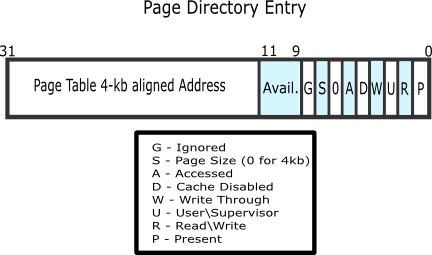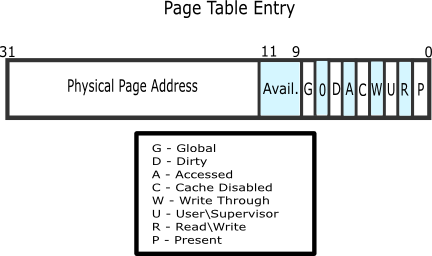- Segmentation is considered obsolete memory protection technique in protected mode by both CPU manufacturers and most of programmers. It is no longer supported in long mode. The information here is required to get protected mode working; also 64 bit GDT is needed to enter long mode and segments are still used to jump from long mode to compatibility mode and the other way around. If you want to be serious about OS development, we strongly recommend using flat memory model and paging as memory management technique.
In Protected mode you use a logical address in the form A:B to address memory. As in Real Model, A is the segment part and B is the offset within that segment. The registers in protected mode are limited to 32 bits. 32 bits can represent any integer between 0 and 4 GiB.
Because B can be any value between 0 and 4GiB our segments now have a maximum size of 4 GiB (Same reasoning as in real-mode).
Now for the difference.
In protected mode A is not an absolute value for the segment. In protected mode A is a selector. A selector represents an offset into a system table called the Global Desc
riptor Table(GDT). The GDT contains a list of descriptors. Each of these descriptors contains information that describes the characteristics of a segment.
Each segment descriptor contains the following information:
- The base address of the segment
- The default operation size in the segment (16-bit/32-bit)
- The privilege level of the descriptor (Ring 0 -> Ring 3)
- The granularity (Segment limit is in byte/4kb units)
- The segment limit (The maximum legal offset within the segment)
- The segment presence (Is it present or not)
- The descriptor type (0 = system; 1 = code/data)
- The segment type (Code/Data/Read/Write/Accessed/Conforming/Non-Conforming/Expand-Up)
For the purposes of this explanation I'm only interested in 3 things. The base address, the limit and the descriptor type.
If the descriptor type is clear (System type) then the descriptor isn't actually describing a segment, it's describing either one of the special gate mechanisms, where to find an LDT, or a TSS. These have nothing to do with general addressing, so I'll assume a descriptor type of 1 (code/data type) and leave you to read the Intel manuals for the rest.
The segment is described by its base address and limit. Remember in real-mode where the segment was a 64k area in memory? The only difference here is that the size of the segment isn't fixed. The base address supplied by the descriptor is the start of the segment, the limit is the maximum offset the processor will allow before producing an exception.
So the range of physical addresses in our protected mode segment is:
Segment base -> Segment base + Segment Limit
Given a logical address A:B (Remember that A is a selector) we can determine the physical address it translates to using:
Physical address = Segment base (Found from the descriptor GDT[A]) + B
All the other rules from real-mode still apply.
The topmost paging structure is the page directory. It is essentially an array of page directory entries that take the following form.

A Page Directory Entry
The page table address field represents the physical address of the page table that manages the four megabytes at that point. Please note that it is very important that this address be 4-KiB aligned. This is needed, due to the fact that the last 12 bits of the 32-bit value are overwritten by access bits and such.
- S, or 'Page Size' stores the page size for that specific entry. If the bit is set, then pages are 4 MiB in size. Otherwise, they are 4 KiB. Please note that 4-MiB pages require PSE to be enabled.
- A, or 'Accessed' is used to discover whether a page has been read or written to. If it has, then the bit is set, otherwise, it is not. Note that, this bit will not be cleared by the CPU, so that burden falls on the OS (if it needs this bit at all).
- D, is the 'Cache Disable' bit. If the bit is set, the page will not be cached. Otherwise, it will be.
- W, the controls 'Write-Through' abilities of the page. If the bit is set, write-through caching is enabled. If not, then write-back is enabled instead.
- U, the 'User/Supervisor' bit, controls access to the page based on privilege level. If the bit is set, then the page may be accessed by all; if the bit is not set, however, only the supervisor can access it. For a page directory entry, the user bit controls access to all the pages referenced by the page directory entry. Therefore if you wish to make a page a user page, you must set the user bit in the relevant page directory entry as well as the page table entry.
- R, the 'Read/Write' permissions flag. If the bit is set, the page is read/write. Otherwise when it is not set, the page is read-only. The WP bit in CR0 determines if this is only applied to userland, always giving the kernel write access (the default) or both userland and the kernel (see Intel Manuals 3A 2-20).
- P, or 'Present'. If the bit is set, the page is actually in physical memory at the moment. For example, when a page is swapped out, it is not in physical memory and therefore not 'Present'. If a page is called, but not present, a page fault will occur, and the OS should handle it. (See below.)
The remaining bits 9 through 11 are not used by the processor, and are free for the OS to store some of its own accounting information. In addition, when P is not set, the processor ignores the rest of the entry and you can use all remaining 31 bits for extra information, like recording where the page has ended up in swap space.
Setting the S bit makes the page directory entry point directly to a 4-MiB page. There is no paging table involved in the address translation. Note: With 4-MiB pages, bits 21 through 12 are reserved! Thus, the physical address must also be 4-MiB-aligned.
Page Table

A Page Table Entry
In each page table, as it is, there are also 1024 entries. These are called page table entries, and are very similar to page directory entries.
Note: Only explanations of the bits unique to the page table are below.
The first item, is once again, a 4-KiB aligned physical address. Unlike previously, however, the address is not that of a page table, but instead a 4 KiB block of physical memory that is then mapped to that location in the page table and directory.
The Global, or 'G' above, flag, if set, prevents the TLB from updating the address in its cache if CR3 is reset. Note, that the page global enable bit in CR4 must be set to enable this feature.
If the Dirty flag ('D') is set, then the page has been written to. This flag is not updated by the CPU, and once set will not unset itself.
The 'C' bit is 'D' bit above.